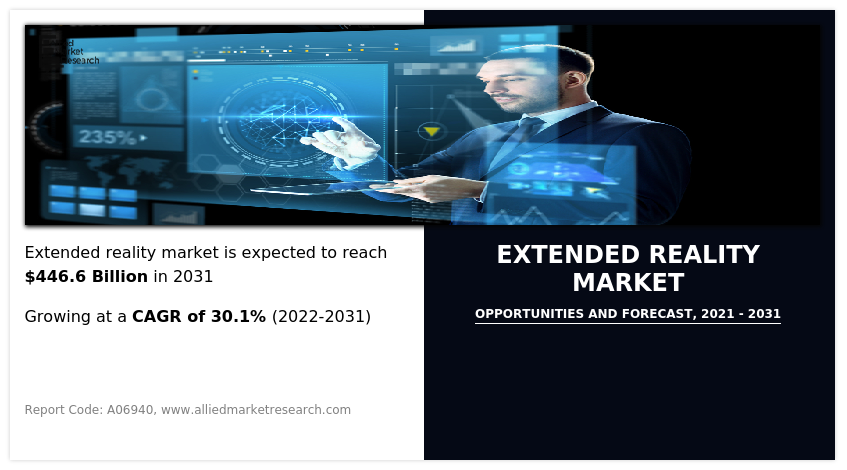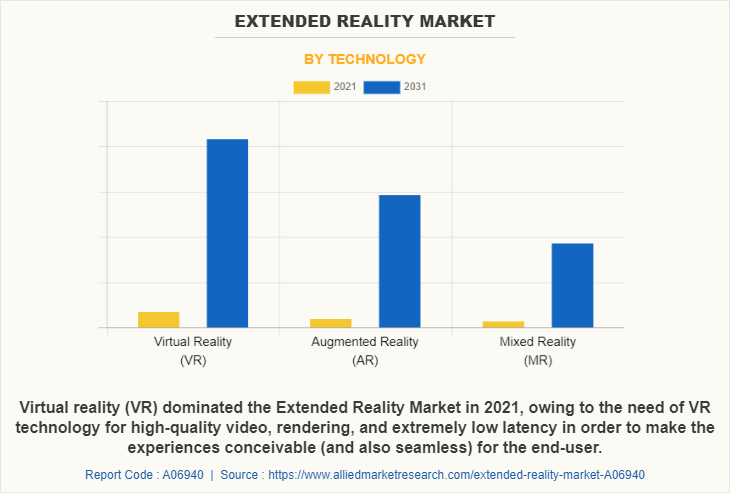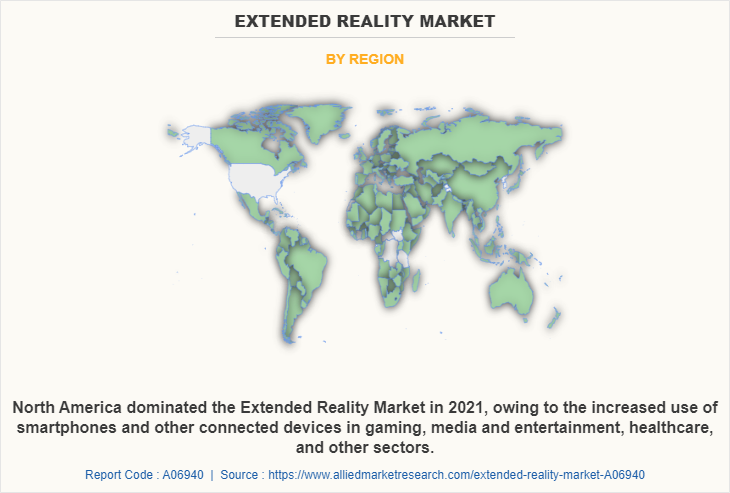Extended Reality Market Overview
The global extended reality market was valued at USD 33 billion in 2021, and is projected to reach USD 446.6 billion by 2031, growing at a CAGR of 30.1% from 2022 to 2031. Surge in investments in extended reality and increasing adoption of XR in healthcare industry primarily drive growth of the extended reality market. Continuous 5G technology advancements are expected to provide lucrative opportunities for market growth during the forecast period.
Key Market Trends & Insights
- Region wise, Asia Pacific is expected to witness significant growth during the forecast period.
- By Technology, Virtual reality (VR) segment is expected to dominate during forecast period.
- By Component, Hardware segment dominated the extended reality market in 2021, and is expected to maintain its dominance in the upcoming years.
Market Size & Forecast
- 2021 Market Size: USD 33 Billion
- 2031 Projected Market Size: USD 446.6 Billion
- Compound Annual Growth Rate (CAGR) (2022-2031): 30.1%
- North America: Highest revenue generating region in 2021.

Extended reality (XR) is a newly coined term that refers to all immersive technology. The ones that are still in development as well as the ones humans already have, such as augmented reality (AR), virtual reality (VR), and mixed reality (MR). By fusing the virtual and "real" worlds together or by generating a completely immersive experience, all immersive technologies expand the reality human’s experience. More than 60% of respondents, according to a recent study, thought XR would become widely used over the next five years.
In a nutshell, Extended Reality (XR) enables people to connect with others while visiting locations virtually and experiencing the same sensations as if they were actually there. As a result, it combines all three technologies - AR, VR, and MR. XR is the fusion of real-world interaction with computer-generated images as well as virtual environments. It is currently used in a number of corporate hiring processes, including onboarding and employee training.
The global extended reality market is segmented on the basis of component, technology, end user and region. On the basis of component, it is bifurcated into hardware, software, and services. On the basis of technology, it is segregated into virtual reality (VR), augmented reality (AR), and mixed reality (MR). On the basis of end user, it is classified into gaming, retail, healthcare, education, manufacturing, aerospace and defense, media and entertainment and others. On the basis of region, it is segregated into North America, Europe, Asia-Pacific, and LAMEA.

On the basis of technology, virtual reality (VR) segment dominated the extended reality market growth in 2021, and is expected to maintain its dominance in the upcoming years, owing to the usage of computer technology to create a simulated environment. Unlike the traditional user interface, VR places the user inside an experience. This means that, instead of viewing a monitor screen in front of them, users are immersed in and can interact with a three-dimensional world.
In recent years, virtual reality technology has also carved out a place for itself in the gaming sector. However, augmented reality is expected segment is expected to witness highest growth, owing to the high demand for AR devices and applications in the healthcare, retail, and e-commerce industries.

Region-wise, the extended reality market size was dominated by North America in 2021 and is expected to retain its position during the forecast period, owing to the increased use of smartphones and other connected devices in gaming, media and entertainment, healthcare, and other sectors aiding the growth of the extended reality market. However, Asia Pacific is expected to witness significant growth during the forecast period, owing to numerous benefits offered by the new immersive technologies, which is expected to fuel the market growth in this region.
Top Impacting Factors
Increasing Adoption of Extended Reality in Healthcare Industry
- The world of medicine and health care has undergone a revolution with the aid of extended reality. Many hospitals and medical centers have expanded their reach owing to innovation and technology. Augmented, virtual, and mixed reality are the three main techniques that reflect extended reality, and they are beneficial for improving healthcare facilities. The use of extended reality in the healthcare industry creates new options for doctors and has promise for the future, particularly for contemporary healthcare institutions. Without endangering patients' lives, the use of extended reality technology in the healthcare industry is lowering costs and improving patient outcomes. Before beginning any medical operation, extended reality technology can assist surgeons in exploring the target organs by imagining the finer details of the patient's body to make it a risk-free process.
- The XR permits doctors to examine the organs carefully and peek beyond the human body. Doctors can use X-rays and 3D structures to investigate even the tiniest parts of the body with the help of technology. For instance, in May 2017 at the Children's Hospital of the University of Minnesota (US), conjoined twins were successfully separated during a pediatric surgical procedure by viewing the connective tissue between the twin hearts using XR.
Increase in Investments in Extended Reality
- Over the past few years, extended reality (XR) has drawn a lot of interest. Virtual, augmented, and mixed reality (VR/AR/MR) technologies are now being invested in by businesses all over the world. A growing variety of use cases for XR are being developed by businesses worldwide, with many of these use cases finding success in immersive training, R&D, virtual collaboration, entertainment, and remote assistance, among other areas.
- In addition, various industries adopt immersive technologies that aid the customer to test prior buying. This enables the user to see the fit of a garment, or a cosmetic testing. Moreover, it also enables to contemplate about furniture and paintings, which eventually reduces the potential returns and enhances the consumer experience. These features have attracted investor’s attention in various sectors such as entertainment, sports, education, tourism, and e-commerce. For major manufacturers, companies such as NVIDIA, have started working with Siemens to build digitally twinned facilities where remote workers can track concerns with the entire facility in real-time.
Key Extended Reality Companies:
The following are the leading companies in the extended reality (XR) market.
- Accenture Plc
- Qualcomm Incorporated
- Adobe Inc.
- Alphabet Inc.
- Microsoft Corporation
- HTC Corporation
- Softserve Inc.
- Unity Technologies
- Sony Corporation
Technological Trends
By utilizing technical advancements, extended reality (XR) creates an environment that is separate from the real world and enables for 3D computer-generated experiences. These innovations from the 19th century prepared the basis for the ultimate development of the current extended reality technologies. More examples of virtual and augmented reality technologies started to appear around the middle of the 20th century. Morton Heilig created the first virtual reality device back in 1956. This gadget provided consumers with a totally immersive watching experience by combining 3D colour TV with sounds, fragrances, and a vibrating chair. Four years later, the creator also secured a patent for the first head-mounted display. A variety of industries, including entertainment, education and training, healthcare, manufacturing, and retail, are already utilizing XR technology in revolutionary ways.
Extended reality holds enormous promise for improving capabilities both within and outside of these areas, whether it makes use of virtual, augmented, or mixed reality components. The COVID-19 pandemic and the ensuing lockdowns, according to Mordor Intelligence, have contributed to the advancement of XR technology, with businesses around the world "trying to find ways to get their internal and wider geographically dispersed teams to communicate, collaborate, and find a path forward during the crisis. The epidemic has also brought to light the potential of immersive technology to address difficulties associated to the pandemic, with opportunities including reenacting vacation experiences, conducting home shopping, and increasing remote learning and working.
Government Initiatives
The federal environmental, industrial and nuclear supervision service most government officials are already aware that incorporating XR requires strong action and that its potential uses will grow with time. Government has the chance to significantly improve its performance through extended reality since it is equipped with instruments to expand human senses and change how user interact with their physical settings. Digital twins can come to life in intricate ecosystems thanks to technology, which can also enable workers to become more skilled, swift, and precise. The potential advantages apply to a variety of federal responsibilities, from field inspectors to warfighters. Additionally, governments have been compelled by the COVID-19 pandemic to implement policies intended at bettering how they interact with citizens, which has improved the quality of public services.
In order to address the most complex needs of individuals in a post-pandemic environment, numerous government agencies throughout the world have started deploying augmented reality (AR) solutions. Furthermore, Virtual reality has had a big impact on government services, just like augmented reality. For instance, since it has improved accessibility for all residents in Australia, virtual reality has become a crucial component of support for social service and firefighting organizations.
Key Benefits for Stakeholders
- This report provides a quantitative analysis of the XR market segments, current trends, estimations, and dynamics of the extended reality market analysis from 2021 to 2031 to identify the prevailing extended reality market share.
- The extended reality market research is offered along with information related to key drivers, restraints, and opportunities.
- Porter's five forces analysis highlights the potency of buyers and suppliers to enable stakeholders make profit-oriented business decisions and strengthen their supplier-buyer network.
- In-depth analysis of the extended reality market forecast assists to determine the prevailing market opportunities.
- Major countries in each region are mapped according to their revenue contribution to the global XR market.
- XR Market player positioning facilitates benchmarking and provides a clear understanding of the present position of the market players.
- The report includes the analysis of the regional as well as global extended reality market trends, key players, market segments, application areas, and market growth strategies.
Extended Reality Market Report Highlights
| Aspects | Details |
| Market Size By 2031 | USD 446.6 billion |
| Growth Rate | CAGR of 30.1% |
| Forecast period | 2021 - 2031 |
| Report Pages | 400 |
| By Component |
|
| By Technology |
|
| By End User |
|
| By Region |
|
| Key Market Players | Adobe Inc., SoftServe Inc., Accenture plc, HTC Corporation, Microsoft Corporation, Unity Technologies, Qualcomm Incorporated, Facebook, Alphabet Inc., Sony Corporation |
Analyst Review
According to CXOs of leading market players, the forecast period will see favorable trends in the extended reality (XR) market. The market is continuously growing due to rising demand for the products. The XR studios are benefiting from the increase in investment rates. In addition, improvements in head tracking technology are increasing the demand in this sector.
Moreover, the market will experience high levels of exigency over the forecast period as a result of these significant factors, and demand will rise as industries' measurements of customer experience advance. A few things prevent the market from growing. There is a significant problem presented by the development of 5G and edge computing technologies. However, the addition of 5G to the XR platform will expand the market's prospects.
In addition, modern imaging techniques in the healthcare sectors such as computed tomography (CT) scans and magnetic resonance imaging also employ XR. Along with the rise in chronic diseases and the growing demand to improve diagnostic accuracy, this is having a positive impact on how XR is utilized in the healthcare industry. In addition, it is anticipated that as more people learn about its benefits, XR's application will expand internationally in the defense, transportation, retail, travel, and tourism sectors.
For instance, in April 2022, CHIETA, the chemical industries SETA, partnered with CXI-Africa, which provides 4IR training focused on Extended Reality (Virtual, Augmented, and Mixed Reality) to deliver training in the exciting world of Extended Reality (XR) Development to 30 candidates. As 4IR rapidly becomes integral to an increasing number of industries throughout South Africa, the need to fast-track skills development in wide-ranging 4IR focus areas is growing. This partnership helps Chieta in advancing their employability within all economic sectors and enables the transformation of business processes to adopt more efficient new frontier technologies in line with global trends and the 4IR policy framework.
The global Extended Reality Market was valued at USD 33 billion in 2021, and is projected to reach USD 446.6 billion by 2031
The global Extended Reality Market is projected to grow at a compound annual growth rate of 30.1% from 2022-2031 to reach USD 446.6 billion by 2031
The key players that operate in the Extended Reality Market such as Accenture plc, Sony Corporation, Qualcomm Incorporated, HTC Corporation, Facebook, Microsoft Corporation, Adobe Inc., SoftServe Inc., Alphabet Inc., Unity Technologies
Region-wise, the Extended Reality Market size was dominated by North America in 2021 and is expected to retain its position during the forecast period
Increasing Adoption of Extended Reality in Healthcare Industry & Increase in Investments in Extended Reality
Loading Table Of Content...



